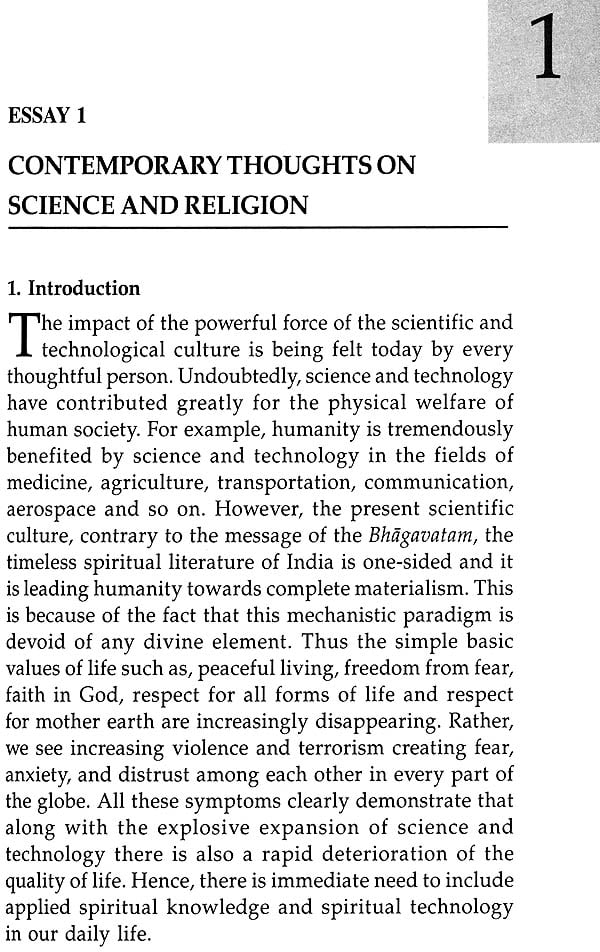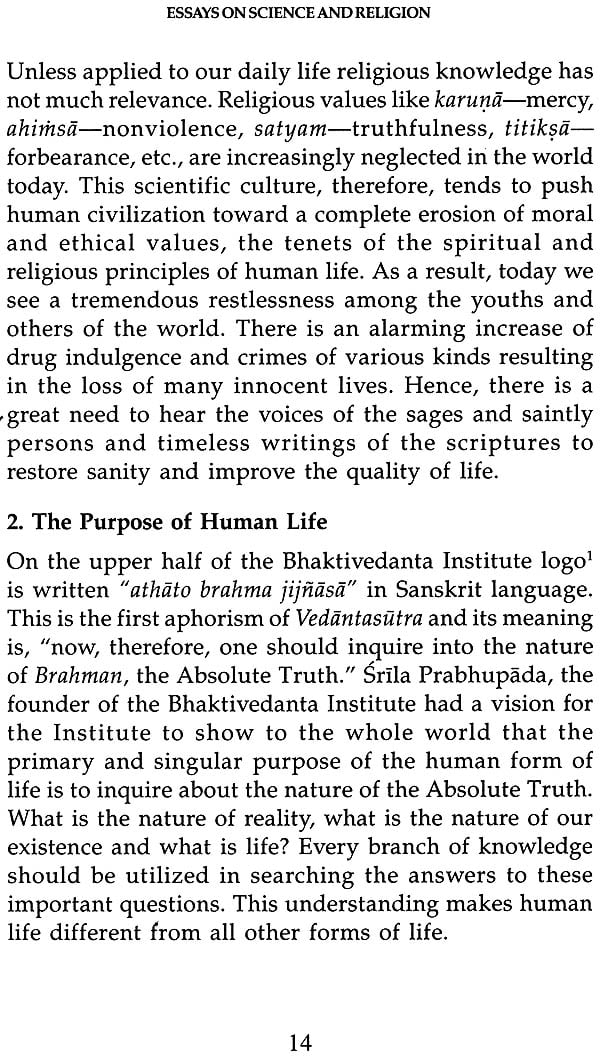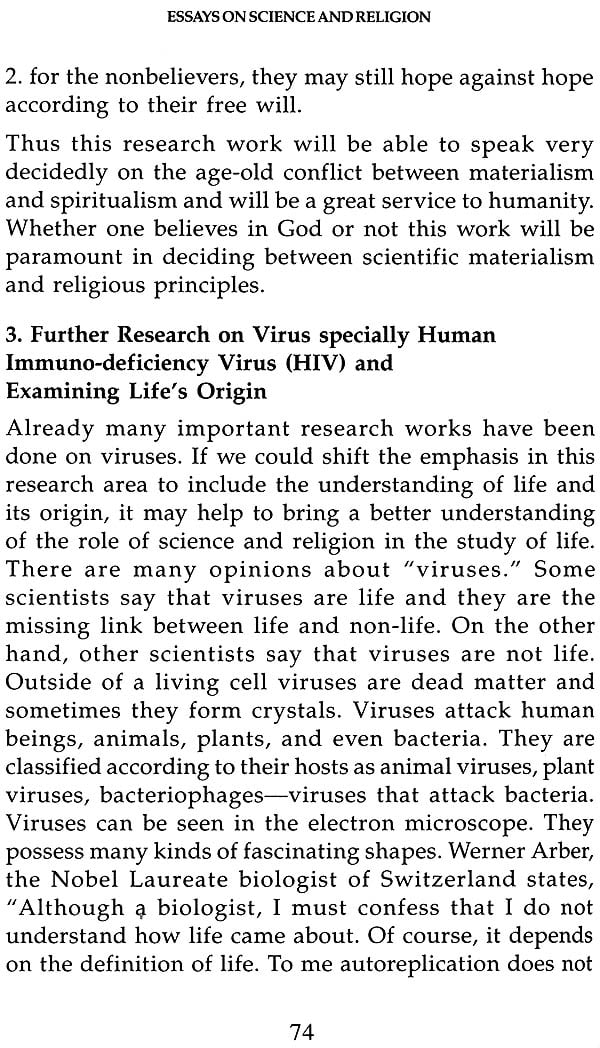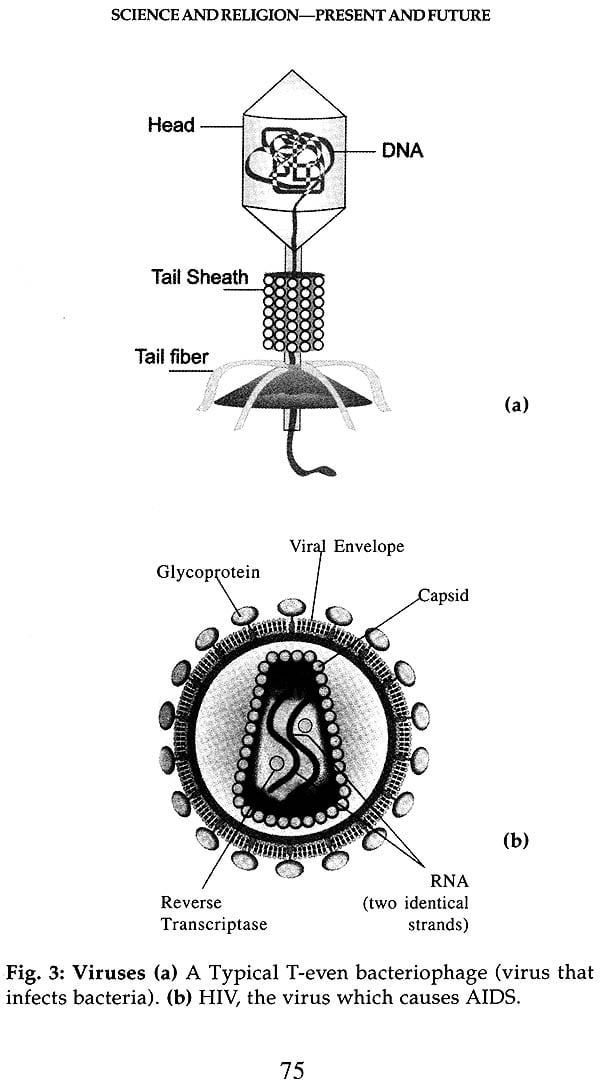
Essays on: Science and Religion
Book Specification
| Item Code: | NAH008 |
| Author: | T. D. Singh |
| Publisher: | Bhaktivedanta Institute, Kolkata |
| Language: | English |
| Edition: | 2015 |
| ISBN: | 9788190136983 |
| Pages: | 104 (Throughout B/W Illustrations) |
| Cover: | Paperback |
| Other Details | 8.5 inch X 5.5 inch |
| Weight | 160 gm |
Book Description
Science and religion are the two most dominant forces of humanity in the search for the ultimate meaning of life and the universe. Are these two forces reconcilable? If yes, what are the possible grounds for their synthesis? Could the recent developments in science and technology about human nature and the cosmos enable us to explore religious wisdom in new ways? In the pivotal times like ours, what role could science and religion dialogue play in restoring world peace? Moreover, what implications would this dialogue have on our future scientific researches? Reflecting on some of these profound issues, Dr. T. D. Singh (His Holiness Bhaktisvarupa Damodara Swami) presents in this volume four groundbreaking essays on science and religion. Dr. Singh is both a scientist with a Ph.D. in Physical Organic Chemistry from the University of California, Irvine, USA and a spiritualist in the Bhakti-Vedanta tradition of India. He has been a pioneer in advancing science and religion dialogue for over thirty years and has authored and edited several books on science and religion. These four remarkable essays by him provide useful insights about the relationship between science and religion in our countinuing quest for the deeper understanding of life and the universe.
Dr. T. D. Singh (His Holiness Bhaktisvarupa Damodara Swami) (1937-2006): A scientist and spiritualist known for his pioneering efforts to interface between science and religion for a deeper understanding of life andthe universe, he received his Ph. D. in Physical Organic Chemistry from the University of California, Irvine in 1974. He has contributed many papers in the Journal of American Chemical Society and the Journal of Organic Chemistry in the field of fast proton transfer kinetics in model biological systems using stopped-flow technique and NMR spectroscopy. He also worked on gas phase reaction mechanisms using Iron Cylotron Resonance (ICR) spectroscopy. He underwent Vaishnava Vedanta Studies (1970-77) under His Divine Grace Srila Prabhupada and he was appointed by Srila Prabhupada as Director of the Bhaktivedanta Institute (1974-), which is a center to promote studies about the relationship between science and Vedanta. He has organized three International conferences on science and religion-First and Second World congress for the Synthesis of Science and religion (1986 and 1997) and First International Conference on the study of Consciousness within Science (1990) where a galaxy of prominent scientists and religious leaders including several Nobel Laureates participated. He has authored and edited several books including What is Matter and What is Life? (1977), Theobiology (1979), Vedanta and Science Series: Life and Origin of the Universe (2004), and Life and Spiritual Evolution (2005), (Ed.) Synthesis of Science and Religion: Critical Essays and Dialogues (1987), Thoughts on Synthesis of Science and Religion (2001), Seven Nobel Laureates on Science and Spirituality (2004), and Science, Spirituality and the Nature of Reality (2005). He is the Founder Editor-in-Chief of the Journal of the Bhaktivedanta Institute entitled, Savijnanam: Scientific Exploration for a Spiritual Paradigm.
Dr. Singh is also the Founder President of Vedanta and Science Educational Research Foundation, Kolkata and a founding member of the United Religions initiative (URI). He is the Founder President of URI's Manipur (North-Eastern India) Cooperation Circle. As an educator, he established a network of schools in North-Eastern India and supervised and guided over 4000 students at these different schools. He is also an accomplished singer, instrumentalist, and poet. He founded "Ranganiketan Manipuri Cultural Arts Troupe" which has approximately 600 performances at over 300 venues in about 20 countries. He started building the University of Bhagavata Culture in Imphal, Manipur, India which will promote the universal scientific and philosophical relevance of the teachings of Bhagavad-gita, Srimad-bhagavatam, Vedanta and other Vedic literatures within the framework of modern cultural and educational milieu for the welfare of humanity.
Science and religion are the two most dominant forces of humanity in search for the ultimate meaning of life and the universe. Are these two forces reconcilable? If yes, what are the possible grounds for their synthesis?
This volume presents four essays which reflect on some profound issues by means of a constructive dialogue between science and religion. These essays were penned by the author for the volumes, Thoughts on Synthesis of Science and Religion and Towards a Culture of Harmony and Peace with some modifications.
The first essay, “Contemporary Thoughts on Science and Religion” presents a detailed outline of scientific and religious thoughts with a special focus on a deeper understanding of life. Drawing upon insights from the timeless writings of the Vedanta, the author presents the Vedantic paradigm of life and its origin. In addition, the essay also features a section on the unity of various religions.
The second essay, “A Vision for the Synthesis of Science and Religion” depicts the common role of ‘faith’ in scientific and religious quests. The essay also reflects on some of mankind’s problems stemming directly or indirectly from modern scientific advancements. The author, then, suggests the need for the inclusion of spiritual elements in modern scientific curricula.
In privotal times such as ours, the question may be asked, ‘what role could science and religion dialogue play in restoring world peace?’ The third essay, “Science and Spirituality for World Peace” is focused on this question. The essay outlines at least five common grounds between science and spirituality for achieving lasting peace.
The last essay, “Science and Religion-Present and Future” examines the role of the study of life’s origin as the key to resolving the conflict between science and religion. The author draws upon some of possible research areas such as the study of viruses, which could help in cementing the scientific and religious paths. The essay also includes a brief description about the ancient holistic medical systems such as Ayurveda system and Yoga practices from Vedic culture which treat individuals physically, mentally and spiritually.
We hope that these four essays will provide useful insights about the relationship between science and religion to all readers in their quest for the deeper understanding of life and the universe.
| Acknowledgements | 9 |
| Preface | 10 |
| Essay 1: Contemporary Thoughts on Science and Religion | 13 |
| Introduction | 13 |
| The Purpose of Human life | 14 |
| Life Comes from Life Paradigm-A Challenge to Darwinian and Reductionistic Model of Life | 22 |
| Unity and Synthesis of Different Religions | 29 |
| Essay 2: A Vision for The Synthesis of Science and Religion | 33 |
| Essay 3: Science and Spirituality for World Peace | 45 |
| Introduction | 45 |
| Synthesis of Science and Spirituality for Lasting World Peace | 48 |
| Some Common Grounds from Science and Spirituality for World Peace | 54 |
| The Role of Faith in Science and Religion | 55 |
| The Domain of Reality beyond Sense Perception | 57 |
| Understanding of the Origin of Life and Its Value | 58 |
| The Role of Science and Spirituality in Studying the Nature of Consciousness | 60 |
| Resolving Ethical Challenges and Achieving World Peace | 63 |
| Concluding Remark | 63 |
| Essay 4: Science and Religion-Present and Future | 67 |
| Introduction | 67 |
| Scientific Research of Life's Origin by Assembling Ready-made Biomolecules | 68 |
| Further Research on Virus specially Human Immuno-deficiency Virus (HIV) and Examining Life's Origin | 74 |
| Religious View of Life's Origin and the Role of Free Will in Human Life | 80 |
| A Brief Scientific and Spiritual Background of Vedic Culture in which Science and Religion Function Co-operatively | 87 |
| Ayurvedic Medicine | 87 |
| Yoga | 89 |
| Suggestions for Further Work | 94 |
| About The Author | 98 |
| About Bhaktivedanta Institute | 100 |









